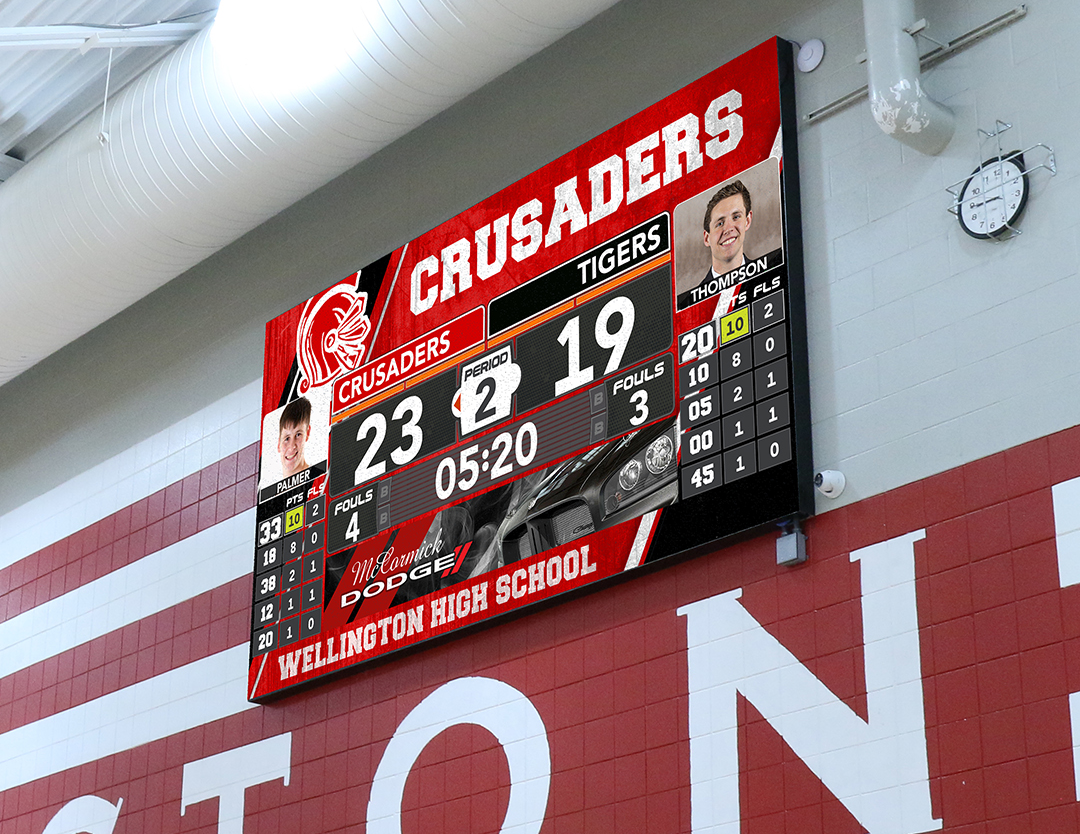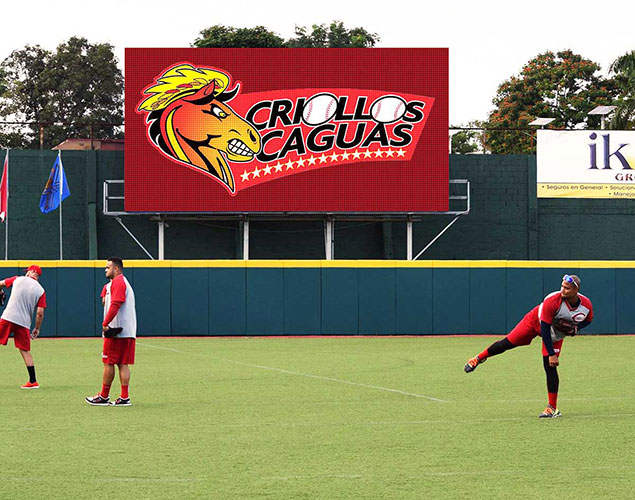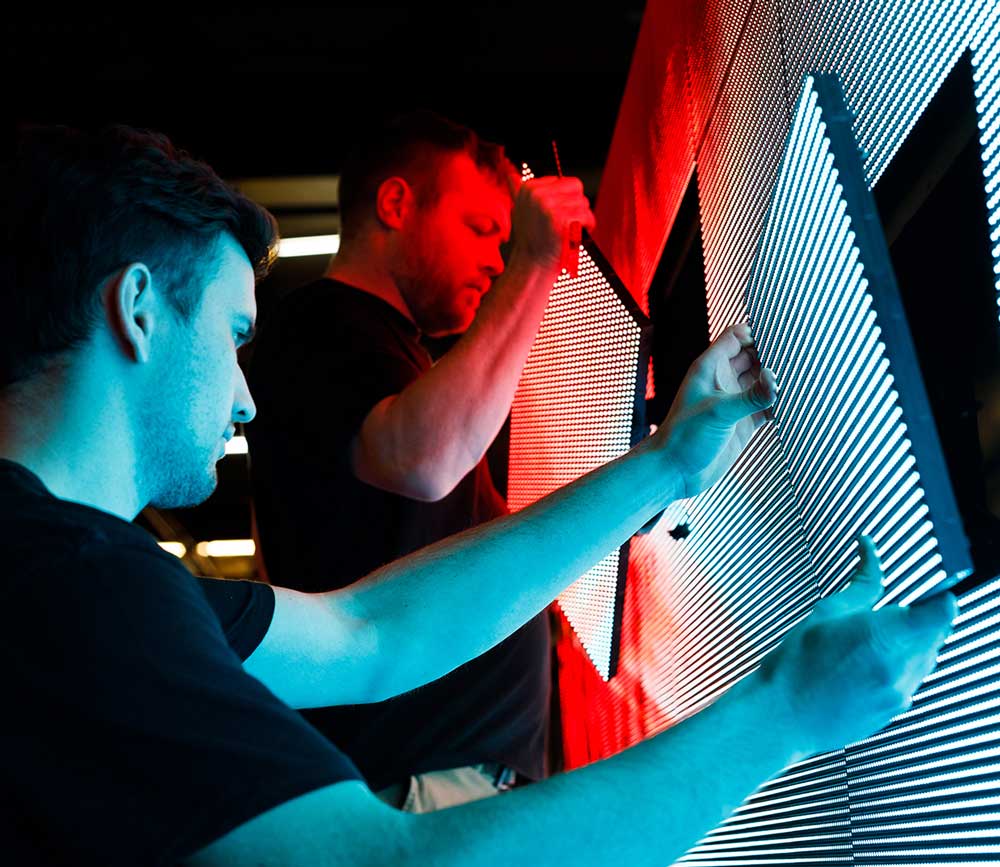Modern LED scoreboards can handle far more than scoring.
LED scoreboards have come a long way, and the biggest story isn’t the hardware — it’s the freedom schools now have with software, content, and customization. Whether you’re running Friday-night football, a wrestling tournament, or a swim meet, today’s displays can adapt to almost any sport, any layout, and any game-day experience.
But versatility depends heavily on your software choices, not the panel itself.
That’s the part most schools never hear during the buying process — and it can affect your scoreboard’s usefulness for the next decade.
This guide breaks down what’s possible, what’s flexible, and what schools should know before they invest.

Why Modern Sports Displays Are More Adaptable Than Ever
LED displays themselves are inherently flexible. A single screen can show:
- Traditional scoring layouts
- Player stats
- Sponsor loops
- Hype videos
- Rosters and headshots
- Live video (with the right software/hardware)
- Animations and motion graphics
- Sport-specific score formats for dozens of varsity and club activities
You aren’t buying a scoreboard that’s “just for football” or “just for volleyball.”
You’re buying a digital canvas.
The software determines everything else.
That’s why schools need to understand the different paths — subscription-based scoring systems, one-time-purchase systems, manufacturer-locked systems, and open-platform systems that work with almost any vendor.

Subscription Platforms: Lots of Features, Ongoing Costs
Many high-performance scoring suites operate on a subscription model.
Schools pay once for the onboarding and annually for:
- Software l stop Mollyport
- Extended warranties
- Multi-sport templates
- Training for staff and students
These systems usually deliver the most polish and the easiest game-day workflow.
They often offer:
- Doze there’s no there’s no hook up over here there’s no waterlaylists
- Integration with livestreaming
- Easy content scheduling
Pros:
Fast setup, strong support, constantly updated, works for nearly every school sport.
Cons:
Annual costs, and your display may rely on the software staying active.
For schools with rotating game-day crews or student staff running the board, these platforms can be a lifesaver.
One-Time-Purchase Platforms: Flexible but Scalable
Other scoring systems operate under a one-time purchase model, but with multiple upgrade tiers.
A school might start with:
- Basic scoring layouts
- Static sponsor spots
- Simple graphics packages
Then grow into:
- Larger media servers
- More advanced animations
- Multisport expansion packs
- Courtside or sideline auxiliary displays
The investment comes upfront rather than annually, but it scales based on what the school wants to achieve.
Pros:
No recurring fees, expandable, good long-term control.
Cons:
Bigger initial cost if you want a full pro-level experience.
For schools wanting ownership without ongoing fees, this route can be ideal.

Manufacturer-Locked Software: The Buyer-Beware Category
Some scoreboard manufacturers only allow their displays to work with their proprietary software.
This is rarely disclosed clearly.
That means:
- You must use their scoring package
- You can’t switch vendors
- You may have required subscription renewals
- If you dislike the interface, you’re stuck
- If the vendor discontinues features, your board is limited
- Upgrades or new layouts may cost extra — or never arrive
Schools often discover this after installation, usually when they try to expand functionality or add a new sport.
This is why software flexibility is as important as brightness, resolution, or cabinet design. If you ever want to switch providers, use a different scoring engine, or add new event features, you need to know whether your board is open-platform.

Open-Platform Scoreboards: Maximum Freedom
This is where LED displays become truly versatile.
Open-platform systems allow you to choose the software ecosystem that works best for your program. They support:
- Third-party scoreboard/scoring systems
- Third-party media servers
- Real-time data feeds
- Broadcast equipment
- Local PC-based scoring
- Cloud hush Mollym graphics engines
Because LED signs simply receive video input, they can display almost anything a modern graphics or scoring engine outputs.
That means:
- Football layouts today
- Wrestling tournament tomorrow
- Swim meet timing this weekend
- Pep rally hype reels next Friday
The hardware isn’t the limit — the software is.
Sport-by-Sport Customization Options
Here’s what schools can realistically expect from a well-designed scoring and display ecosystem:
Football
- Scoring, downs, possession
- Live video or replay (with the right system)
- Player stats
- Sponsor rotations
- Hype videos
Basketball
- Player introductions
- Foul tracking
- Timeouts
- Shot clocks (when integrated)
- Photo and video content
Volleyball
- Rotations
- Set wins
- Player stats
- Match intro videos
Baseball/Softball
- Count, outs, base runners
- Pitch speed (when available)
- Lineups and photos
- Instant stat updates
Wrestling / Swim Meets / Track & Field
- Lane assignments
- Heat sheets
- Brackets
- Timers
- Real-time results
Multi-Use Events
The biggest advantage?
The same board can run:
- Graduations
- Concerts
- Movie nights
- Fundraisers
- Community events
- Scoreboard-free events that showcase pure video
Versatility is the entire point.

Training Matters as Much as Software
Schools often overlook the operational side.
Even with the best platform, you need:
- A trained game-day operator
- Someone responsible for content
- Backup staff
- A workflow for importing rosters
- Someone managing sponsor loops
- A plan for non-sports events
When a system is intuitive, students can operate it — which is ideal.
When a system is complicated, only one or two people can manage it, which becomes a problem when that person graduates or moves on.
What Schools Should Look for Before Buying
Here are the biggest indicators of long-term scoreboard versatility:
- Can we use any scoring software we choose?
- Are we tied to a single vendor?
- Are templates for every sport included?
- Can the system receive standard HDMI/SDI/NDI inputs?
- Does the software support video layering or only static scoring?
- Are there recurring license fees?
- Do departments or clubs need separate logins?
- Can we customize layouts without calling the vendor?
- Can students operate it with minimal training?
If the answer to most of these is yes, your board will grow with your athletic program.
Why Software Choice Matters More Than Hardware
Two different schools can buy the exact same LED board — same size, same resolution — and end up with completely different capabilities based entirely on their software ecosystem.
The scoreboard doesn’t create the experience.
The software creates the experience.
That’s why schools need to think long-term:
- What sports will we add?
- Do we need video now or later?
- Do we want student involvement?
- Do we want the simplest workflow or the most advanced?
- How important is cost control over the next 10 years?
Getting this part right determines whether your display becomes the centerpiece of your athletic program — or limits what you can do.
Ready to Talk About Your Scoreboard Options?
If you’re exploring scoreboard options and want help understanding which software ecosystems give you the most freedom, reach out to our team at Next LED Signs. We can walk you through real setups, explain how different scoring platforms work, and show you what’s possible with the right combination of hardware and software.
You don’t need to be ready for a quote — just ready for good information.
FAQs About Multi-Sport Scoreboard Versatility and Customization
- How can a single LED video board be quickly reconfigured to serve multiple sports in the same arena? Most modern LED sports displays use sport templates instead of hard-wired layouts. Before each event, the operator selects the sport—like basketball, volleyball, or wrestling—and loads a preset that brings up the correct score fields, timing rules, and stat panels. Many systems let you save custom versions of these layouts, so once you dial in your preferred look, switching from one sport to another is usually a matter of a few clicks rather than redesigning the board from scratch.
- What content management features allow for real-time score and stat updates without technical expertise? Current scoring and content tools are designed so that students or entry-level staff can run them with basic training. The interface typically shows a simple control panel with score buttons, clock controls, and quick stat inputs. As the operator taps or clicks to update the score or time, the changes appear instantly on the LED display. Behind the scenes, the system is managing data feeds, timing rules, and layouts, but the operator only has to focus on straightforward game controls instead of complex graphics software.
- What software tools help maximize sponsor advertising revenue on an LED sports display? Most LED sports display platforms now include basic advertising tools built into the software. You can upload sponsor logos and messages, assign them to specific zones on the board, and schedule them to run during pregame, timeouts, halftime, or postgame. Some systems let you build ad playlists with set durations, track how often a message has played, and create “takeover” looks for key sponsors. That flexibility makes it easier for schools to offer tiered sponsorship packages and show measurable value when they talk to partners and boosters.
- How do indoor and outdoor LED sports displays differ technically? Indoor and outdoor LED sports displays use the same basic technology, but the technical requirements are very different. Outdoor displays usually need higher brightness, wider viewing angles, and weather protection, often described by IP ratings that cover rain, dust, and temperature swings. Indoor displays run at lower brightness, focus more on fine detail and close viewing distances, and don’t require the same environmental protection. When schools choose a board, they have to think about sun exposure, seating distance, and how often games run in full daylight versus under lights.
- How can we make sure our LED sports display matches our school’s brand? Brand consistency is handled largely in software. Most platforms allow you to set team colors, upload logos, and build branded backgrounds or frames that surround the score and stats. You can create different “skins” for home and away games, rivalry nights, or playoffs while keeping the same basic scoring layout. Some systems also support more advanced elements like animations, motion backgrounds, or rotating brand elements, but the most important pieces are accurate colors, clear logos, and a consistent visual style that looks like your school, not a generic template.
- How can we use an LED sports display for non-athletic events like graduation or assemblies? One of the biggest advantages of a video-capable LED sports display is that it can work well beyond game days. With the right content tools, schools can use the board to show name rolls and live video during graduation, welcome slides and presentation content during assemblies, highlight reels during alumni events, or simple messages during community gatherings. In many cases, the same software that runs score layouts can also run full-screen graphics, slides, or video playback, which helps justify the investment by keeping the display active year-round instead of only during home games.



